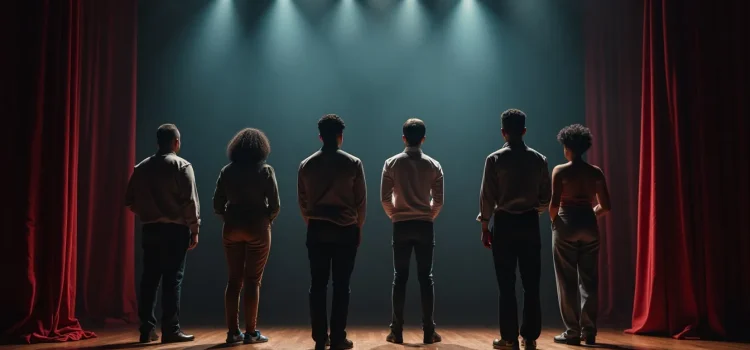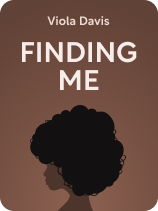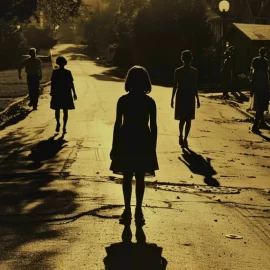

This article is an excerpt from the Shortform book guide to "Finding Me" by Viola Davis. Shortform has the world's best summaries and analyses of books you should be reading.
Like this article? Sign up for a free trial here.
Are you tired of seeing the same stereotypes in movies and TV shows? Have you ever wondered about the real experiences of Black actors in Hollywood?
Racism in the arts remains a pervasive issue, as highlighted by Viola Davis’s journey in the entertainment industry. From her early inspiration watching Cicely Tyson to her groundbreaking role in How to Get Away With Murder, Davis’s story reveals the challenges and triumphs of Black actors in a predominantly white industry.
Keep reading for a powerful exploration of representation, stereotypes, and the fight for authentic portrayals in Hollywood.
Racism in the Arts
Viola Davis shares the story of her dream of acting and eventually making it big. Her journey sheds light on experiences of racism in the arts. Davis says she figured out what she wanted to be when she was about nine years old. One night, while watching TV, Davis saw Cicely Tyson performing in The Autobiography of Miss Jane Pittman. Davis had never seen a dark-skinned actor before—someone that looked like her. It was then that Davis knew she wanted to be an actor.
(Shortform note: Cicely Tyson was a trailblazing American actress and model whose career spanned more than seven decades. Like Davis, Tyson was known for her commitment to portraying African American women with dignity and complexity, refusing parts that perpetuated stereotypes. She received an Oscar nomination for her role in Sounder (1972) and an Emmy for her performance in The Autobiography of Miss Jane Pittman (1974). Tyson’s impact on Davis came full circle when Tyson played the role of Annalise Keating’s stubborn and fiercely loving mother on How To Get Away With Murder, giving Davis the opportunity to share the screen with her first inspiration.)
Racial Norms at Juilliard
After some small acting roles in her early life, Davis wanted to do more. Following advice from a friend, she decided to apply to Juilliard, a renowned school for performing arts. Davis attended Juilliard from 1989 to 1993.
In reflecting on her time at the prestigious institution, Davis emphasizes how challenging it was, not only because of the rigorous coursework and time commitment, but also because Juilliard’s standards for acting were based on white cultural norms. Davis explains that, while she was asked to stretch in new ways as an actor, she was also asked to diminish her blackness, to mold herself into the ideal of a white actor. According to Davis, Juilliard only taught a Eurocentric theater canon; any work outside of that scope wasn’t considered worthy of consideration. While earlier experiences of racism had made Davis feel small, her experience at Juilliard made her angry.
| The Debate Over Racism at Juilliard Juilliard has continued to face criticism for what alumni and students have called racist practices. After the murder of George Floyd in 2020, the school, like many institutions, expressed its commitment to antiracism, introduced diversity curricula, and offered a series of workshops. Many students felt the changes didn’t go far enough. Furthermore, a problematic workshop that involved an auditory recreation of the African slave trade upset many Black students. The school canceled future workshops and issued an apology. The workshop incident sparked outrage and students issued a list of demands, including an end to colorblind casting and the implementation of more comprehensive and historically accurate educational content that fully represents the contributions and experiences of Black individuals and communities. Critics argued these demands could restrict artistic freedom by prioritizing identity over creative exploration. The controversy reflects a wider debate on balancing tradition and progress within the arts. Juilliard continues to face pressure to overhaul its classical curriculum to better represent Black students, mirroring calls for radical change across the theater world for greater diversity. |
Davis wrote an essay about her experience as a Black woman at Juilliard and earned a scholarship to pursue a professional development opportunity outside of her normal coursework. She traveled to Gambia with a small group of students to study the dance, music, and folklore of several West African ethnic groups. Davis describes the trip as an awakening. For the first time, Davis saw blackness as something beautiful that should be celebrated.
Upon her return to Juilliard, Davis presented a one-woman performance, which she described as the culmination of everything she’d learned in West Africa. The performance was met with critical acclaim.
Racial Stereotypes in Acting
In her early acting career, Davis was coming up against the interconnected forces of racism, colorism, and sexism. The few casting directors who were casting for roles for women of color were looking for “light-skinned” women or women who were more racially ambiguous. More often than not, Davis says, she found herself getting auditions for parts playing crack-addicted mothers or other roles equally steeped in negative racial stereotypes.
| Colorism in a Global Context In Hollywood, as highlighted by the experiences of actors like Davis, the issues of racism, colorism, and sexism are deeply intertwined, often resulting in casting choices that perpetuate negative stereotypes. These practices are not isolated to the American entertainment industry but can be seen in various forms across the globe, each reflecting its unique socio-cultural nuances. For example, in Bollywood, the Indian film industry, there’s a notable preference for lighter skin tones—a reflection of long-standing colorist attitudes within the society. This has historically translated into casting practices where lighter-skinned actors are favored for leading roles, often sidelining talented darker-skinned actors or relegating them to typecast roles. Additionally, Bollywood has faced criticism for its portrayal of gender roles and stereotypes, with women often depicted in reductive, secondary positions to their male counterparts. |
Davis explains that, throughout her career, she was consistently offered roles that were underdeveloped—women who were simply caricatures, stereotypes, or lacking in depth. Therefore, Davis took it upon herself to inject these roles with as much humanity as she could, demonstrating her commitment to bringing authentic, multidimensional characters to life, despite the limitations of the roles she was offered.
| A History of Black Stereotypes in Film From the early 20th century, Black characters in film were largely trapped in demeaning roles that perpetuated deeply embedded racist stereotypes. D. W. Griffith’s The Birth of a Nation (1915) is a prime example, as the movie glorified the Ku Klux Klan while depicting African Americans as subservient, violent, and unintelligent. The Harlem Renaissance in the 1920s and ’30s brought advancements in Black cinema, with directors like Oscar Micheaux telling stories featuring Black professionals. By the mid-20th century, the Civil Rights Movement had begun to influence Hollywood, slowly eroding the most egregious stereotypes and introducing more complex roles for Black actors. The latter part of the 20th and the early 21st centuries witnessed a more decisive shift towards diversity and authenticity, as seen in works like Spike Lee’s Do the Right Thing (1989) and Marvel’s Black Panther (2018). These films, among others, played crucial roles in redefining the narrative around Black characters, portraying them in empowered and nuanced roles. However, despite these advances, the film industry continues to grapple with accusations of tokenism, typecasting, and a lack of representation behind the scenes, as evidenced by the 2015 #OscarsSoWhite movement. |
Davis was cast as Aibileen Clark, a 1960s housemaid, in the 2011 film The Help. Though many criticized the movie for perpetuating racial stereotypes, Davis’s performance was celebrated for the nuance and humanity she brought to the role. Her performance earned her several nominations and awards, including an Academy Award nomination for Best Actress.
Davis’s career took a monumental turn when she was cast as Annalise Keating in the TV drama How to Get Away With Murder (2014-2020). This role provided Davis an unparalleled chance to portray a complex, brilliant, and flawed black woman, showcasing her acting depth and earning her widespread acclaim. Notably, she made history as the first Black woman to win a Primetime Emmy Award for Outstanding Lead Actress in a Drama Series. The show’s success and Davis’s powerful performance significantly elevated her profile in Hollywood, opening doors to more diverse and complex roles.
(Shortform note: Many have compared Davis’s role as Annalise to Kerry Washington’s role as Olivia Pope in Scandal, which aired from 2012-2018. However, while both characters are strong, complex Black women leading major network shows, others argue that they’re fundamentally different. While Olivia Pope is portrayed as a crisis management expert with a polished exterior, navigating political landscapes, Annalise Keating is raw, flawed, and morally ambiguous. This contrast not only showcases the range and depth actors like Davis bring to their roles but also illustrates a shift from roles that are merely “strong” in a conventional sense to those that are intricately layered and humanized, offering a richer tapestry of Black womanhood on screen.)
On a personal level, playing Annalise catalyzed Davis’s journey towards self-love. The character’s complexities, often absent in Black female roles on TV, empowered Davis to challenge internalized societal norms about Black women. In a significant on-screen moment, Davis removed Annalise’s wig and makeup, embracing her natural appearance—a powerful rejection of Hollywood’s limited beauty standards. In portraying Annalise’s strength and emotional depth, Davis explains how she was also able to celebrate her authentic self, her strengths, and her vulnerabilities.
(Shortform note: While the choice to remove her wig and makeup was a profound moment for Davis, it also meant a lot to many Black women. In her book You Can’t Touch My Hair, Phoebe Robinson describes the scene as the most pivotal moment in the history of television for Black women. She explains that the scene challenged long-standing stereotypes about the strong Black woman and offered a rare glimpse into the intimate beauty routines of Black women, which are rarely shown in mainstream media. According to Robinson, this scene deeply resonated with many Black women, providing them with a sense of representation that had long been absent, while also granting non-Black viewers a window into their experiences.)
Paving the Way for Others
According to Davis, her career has never just been about her own success. Davis’s journey through the entertainment industry has been marked by numerous obstacles, many stemming from systemic racism and sexism.
Driven by her personal experiences, Davis has committed herself to challenging these biases. She consciously pursues complex and diverse roles that defy stereotypes, presenting a more authentic portrayal of Black women’s experiences. Through her work, Davis fights against the discrimination that pervades the industry, striving to uplift diverse narratives from marginalized communities. In partnership with her husband, Davis also founded JuVee Productions, a production company that seeks out and develops projects that center on marginalized perspectives, amplifying stories that might otherwise be overlooked.
(Shortform note: One of the ways that Davis and her husband Julius Tennon uplift diverse voices in the entertainment industry is through JuVee Productions’ Emerging Artist Series. This initiative is focused on identifying, supporting, and showcasing the talents of upcoming artists from various disciplines, encouraging creativity and offering a valuable opportunity for these individuals to gain visibility and recognition in a competitive field.)
Exercise: Reflect on Black Women’s Representation in the Arts
In Finding Me, Viola Davis shares her journey navigating the complex landscape of Hollywood, shedding light on the broader issue of representation in the arts, especially for Black women.
- Reflect on the current landscape of media and entertainment. How are Black women represented in the movies, TV shows, and other media you consume? Are these representations generally positive, negative, or stereotypical? Give examples to support your observations.
- Think about your own role as a consumer of media. How can you support and advocate for better representation of Black women in media? This could be through the shows you watch, the content you share on social media, or even the conversations you have with friends and family. Write down one actionable step you can take to contribute to positive change.

———End of Preview———
Like what you just read? Read the rest of the world's best book summary and analysis of Viola Davis's "Finding Me" at Shortform.
Here's what you'll find in our full Finding Me summary:
- The story of Viola Davis’s rise from the depths of poverty to the heights of Hollywood stardom
- How acting became a beacon of hope for Davis and a path toward self-discovery
- What Davis does beyond her acting career






